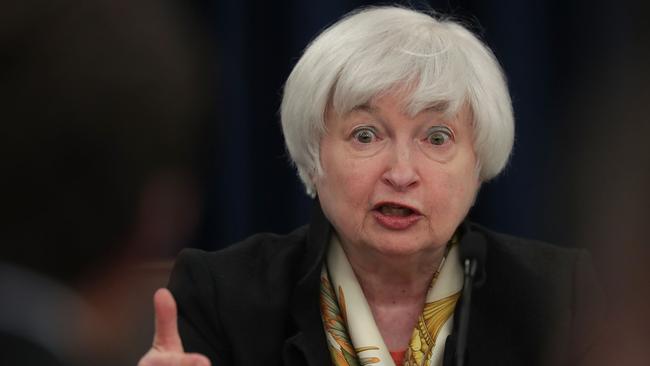The US Federal Reserve is caught in a bind of its own making

Overnight, the Fed’s policy statement showed that members of its Open Market Committee are continuing to back away from the expectation they had for the course of US rates this year.
Where, at the start of the year, they were signalling as many as four rate rises this year, they now expect no more than two and six of the 17 members now see only one. They have also lowered their predictions for where rates will be in 2017 and 2018.
It seems that every time the Fed has met this year it has found a fresh excuse — financial market volatility, payroll data or the “Brexit” vote — to defer a decision to raise rates.
In a speech to a World Bank conference last week, the Bank for International Settlements’ Hyun Song Shin made the point that exchange rates are “back in the news.”
“It is a cliche that the world has become more connected but the external dimension of monetary policy has figured more and more prominently in central bankers’ speeches recently,” he said.
“Financial markets, for their part, appear to be tethered more closely than ever to global events and the real economy appears to dance to the tune of global financial developments rather than the other way round.
‘’If you will excuse a rather extravagant metaphor, the financial tail appears to be wagging the real economy dog,’’ he said.
The core of his analysis was that global financial conditions have become extremely sensitive to the shifting value of the US dollar and consequently to “every twist and turn” in the monetary policy debate in the US.
The US dollar weakened after the Fed’s statement overnight.
There has been dramatic growth in cross-border bank claims denominated in US dollars in recent years, driven by its role as the dominant invoicing currency for international trade and investment and associated hedging and borrowing. The stock of US dollar-denominated debt of non-banks outside the US now stands at $US9.7 trillion, Shin said.
He noted that when the dollar strengthens, there have been declines in aggregate cross-border liabilities, implying that banks have been less willing to roll over hedges put in place during earlier periods of ample dollar liquidity.
Thus a weaker dollar generates greater dollar-denominated lending, lower volatility and more risk-taking while a stronger dollar leads to higher volatility and less risk-taking, with the impacts flowing through to real economies.
It was the Fed’s resort to historically low rates and unconventional monetary policies at the onset of the financial crisis, with Europe and Japan following its lead, that coincided with a massive stimulus program within China and ignited both real economic activity in emerging market economies and a commodity bubble.
As the Fed started to wind back its bond and mortgage buying activity and started to signal its intention of normalising US rates over time, the commodity bubble burst.
What that has demonstrated is how acutely sensitive financial markets and real economies have become to US monetary policy and its implications via the currency markets channel.
The US dollar has become even more dominant in financial market activity than ever in an environment where the “financialisation” of commodities and other non-financial assets, and the globalisation of markets, has given financial markets a larger influence over global economic conditions than ever before.
The Fed is now caught in a “Catch 22” of its own making. It wants to extricate itself from policy settings that don’t reflect the underlying condition of the US economy, which has been growing quite solidly, and which give it no room to manoeuvre if the economy were to turn down.
Yet, if it raises rates, it will push up the value of the US dollar, depressing US economy activity but also injecting real volatility into financial markets where valuations are stretched and where there is considerable leverage.
In an inversion of conventional wisdom about relative exchange rates, it would tighten financial and economic conditions elsewhere, particularly in emerging market economies, because of the impact on the cost and availability of US dollar-denominated funding. That would adversely impact global and US growth and financial stability.
The Fed appears paralysed by the dilemma, looking for any excuse not to raise rates rather than for reasons why it should, with the financial markets feedback to its inaction reinforcing it and pricing in ultra-low US and global rates and funding costs indefinitely.
After nearly eight years of unconventional monetary policies with only weak global growth, mainly fuelled by China and its satellite economies, the world is now more sensitive to fluctuations, or expectations of change, in the value of the US dollar than ever before.
That complicates independent actions by the Fed and makes its still-planned gradual exit from the cheap money era and the normalisation of US rates a far more difficult and dangerous exercise than it might have contemplated when it began what it envisaged as a steady procession of modest rate increases over the next several years last December.




A speech last week by the head of research for the central bank for central bankers helps put the US Federal Reserve’s apparent dithering over the future of US interest rates into perspective.